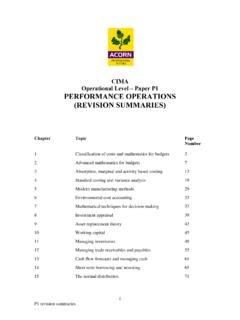Transcription of Chapter 9 Leadership - acornlive.com
1 1 Leadership Chapter 9 2 Leadership theory Leadership is a process by which a person influences others to accomplish aims or objectives, using their capacity to motivate, inspire and influence others. Leadership is related to other management concepts such as motivation, communication, authority, power and delegation, it is the relationship through which one person influences the behaviour and actions of other people. Leadership or management style is about the way a relationship is handled between a manager and their sub-ordinate(s). Generally two contrasting Leadership or management styles exist Democratic Leadership styles reduce the power differential between a manager and subordinate, this management style is based upon the principles of democracy and social equality.
2 A democratic manager will ask for opinions from subordinates, and will amend their original idea or decision, if required, from consultation. Participation from all sub-ordinates is encouraged. Autocratic Leadership styles which are a more bossy way of managing sub-ordinates, based upon centralised decision making by the manager, who is often impatient, aggressive and dominating. An autocratic manager would not encourage participation in decision making from their sub-ordinates. The position as a manager gives the authority to accomplish certain tasks and objectives, but this power or influence, perhaps through official job title, does not make a manager a leader. Being a manager makes you the boss , but being a leader means to motivate, inspire and influence others followers , to achieve aims or objectives, not just from bossing them around.
3 Natural leaders have the power to initiate action without any formal authority. Leadership trait theory is centuries old and based on the idea that there are certain personality traits that an individual may be born with that make them successful leaders. The idea that Leadership is in your genetics and something you are either born with or not. In summary leaders are different types of people from followers and are born to be leaders; however this theory has been widely criticised. In response to this developed the behavioural theory of understanding Leadership , that is theorists who began to research Leadership as a set of behaviours, evaluating the behaviour of successful leaders, determining situational approaches to Leadership and identifying a broad range of different Leadership styles.
4 They turned attention to what leaders did and how they behaved or could behave towards their sub-ordinates. Behavioural theories of Leadership support the idea that behaviour of leaders distinguishes them from their followers and also that Leadership is a skill that can be taught. Characteristics or personality traits of good leaders Trustworthy and a good listener Enthusiastic and need for achievement Confident and competent Inspirational and motivational Coach and counsellor Good communicator and well organised Tolerant, diplomatic and intelligent Committed to excellence Adaptable and flexible 3 Transactional and transformational Leadership Transactional Leadership is a style of management based on the setting of clear objectives for sub-ordinates and with punishment or reward to promote or encourage compliance carrot and stick approaches to management.
5 This style focuses on the management role of direct planning, direction and supervision of the sub-ordinate and very much the belief of the classical school of management thought (see Chapter 10), like transactional leaders they focused more on the task and on increasing the efficiency of structured routines and procedures by work study and standardisation of work design. According to Vera and Crossan, transactional Leadership is about setting goals, articulating explicit agreements regarding what the leader expects from organisational members and how they will be rewarded for their efforts and commitment, and provide constructive feedback to keep everybody on task . James MacGregor Burns explained that transactional leaders exchange tangible rewards for the work and loyalty of followers.
6 The focus of motivation is therefore to concentrate on the sub-ordinates extrinsic needs pay, perks and working conditions, factors which are removed from doing the job itself. This type of style works by specifying standards and objectives, with exchanges of reward and promise for the subordinate s effort. It like autocratic management styles tends to be more effective in crisis and emergencies, or when tasks can be carried out in a standardised or structured manner. McGregor s theory X (see later) also is similar to the principle of transactional Leadership where managers rule by fear of punishment and the promise of reward. McGregor s theory Y is similar to transformational Leadership which focuses on the higher order intrinsic needs of sub-ordinates, such as the need for self-fulfilment through challenge, responsibility and recognition for achievement.
7 The theory Y style works on encouragement of sub-ordinates with the management belief that sub-ordinates are trusting, respectful and self-motivated. According to James MacGregor Burns, transformational Leadership is when leaders and followers make each other to advance to a higher level of morality and motivation . With transformational Leadership the strength of vision, personality and ability of the leader is to motivate, energise and inspire sub-ordinates to attain challenging goals. Rather than motivation by the carrot and stick approach of transactional Leadership , instead motivation is gained by self-fulfilment by sub-ordinates, also by respect and admiration for the leader. Components for transformational Leadership Bass suggested four different components of transformational Leadership .
8 Intellectual Stimulation leader challenges the status quo, encourages creativity and to explore and learn new ways of doing things. Individualised Consideration coaching, support and encouragement to support relationships. Inspirational Motivation instils a clear vision and gains a similar passion from sub-ordinates. Idealised Influence role model of leader with high levels of trust and respect. Distributed Leadership Distributed (collective, shared or horizontal) Leadership means collaborative working with high trust and respect for every member s contribution, similar to the idea of a task culture. Through shared and active engagement, distributed Leadership can result in the development of Leadership capacity to achieve improvements in creativity and knowledge management.
9 4 Characteristics of distributed Leadership High trust in the expertise of individuals rather than regulation. Culture of autonomy rather than management control. Participative approaches to decision making and change. Leadership capacity and authority is distributed. Learning and flexible culture Huneryager and Heckman (1967) four styles of management Dictatorial 100% complete centralisation of decision making by the manager. Manager makes decisions and enforces upon subordinates, who obey without question no consultation with sub-ordinates. Autocratic Manager sells or bosses subordinate to accept decisions some, but little consultation with sub-ordinates. Democratic Manager will ask for opinions from subordinates, high level of consultation and participation in decision making by sub-ordinates.
10 Laissez faire 100% complete decentralisation of decision making by the manager, or total empowerment given to subordinates. Laissez faire is a French phrase meaning "let it be", a manager who acts as their sub-ordinates wish. Dictatorial Task centred manager Autocratic Democratic Laissez faire Group centred manager Management style spectrum 5 Advantages and disadvantages of different Leadership styles Dictatorial complete centralisation No consultation with subordinate. Manager tells subordinates what to do, they obey without question. Advantages Speed and efficiency of decision making by the leader Good in times of urgency or crisis, where quick decisions need to be made Sub-ordinate may not have the experience to be consulted with Disadvantages Sub-ordinates opinions ignored Overdependence on leader hard to make decisions in the leaders absence No confirmation of understanding from sub-ordinate when told Democratic High level of consultation and participation in decision making by manager and sub-ordinates.

















